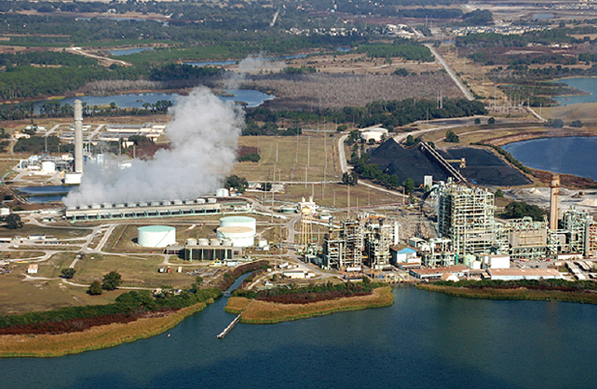The sinkhole that collapsed at a fertilizer plant in Mulberry last month makes this painfully clear: an unknown amount of material “stored in gypsum stacks” (much like the toxic gypsum stacks that store coal ash) plummeted into the Floridan aquifer -- the drinking water supply for 5,000 individuals within the immediate area, and a million others whose drinking water is derived from the aquifer.
The radioactive water, now laced with sulfate and sodium, has contaminated at least 215 million gallons of water in the Floridan aquifer, an underground source of freshwater for residents across the state.
The estimated cost of a cleanup? A cool $50 million.
Yet just up the road, the city of Lakeland faces a similar problem. Polk County residents are at risk for basic access to fresh, safe water. The C.D. McIntosh Jr. coal plant was constructed in karst terrain, a natural landscape that is predisposed to sinkhole formation. Sinkholes near McIntosh and other coal plants may allow coal ash ponds to contaminate local aquifers, and thus the entire groundwater supply source for residents.
Floridians are highly dependent upon groundwater; over 90% of the state’s freshwater supply is sourced from underground aquifers.
The McIntosh plant would not meet the safety standards under the U.S. Environmental Protection Agency’s Effluent Limitation Guidelines (ELGs) and Coal Ash Rule, which take effect in 2018. According to a study conducted by Dr. Mark Stewart of the University of South Florida, the geographical instability of the terrain and lack of sinkhole protection among the plant’s facilities make it especially prone to leaking toxic waste into the local aquifer through natural sinkhole formations. "The facilities were not built to withstand the influence of sinkholes," Stewart stated in the study. “They lack the structural reinforcement that would be necessary, but may not even be sufficient, to prevent a sudden foundation collapse."
However, Lakeland is not alone; the Crystal Energy River power plant in Citrus County shares a similar dilemma. It was also built upon sinkhole-prone terrain. Its waste disposal and storage facilities place the local water supply at risk, and fail to meet the Environmental Protection Agency’s Coal Combustion Residuals rule. Since 2012, water quality samples have shown that wells near the plant’s landfill are becoming increasingly contaminated. Complicating matters further are the twenty-four reported sinkholes within a five mile radius of the plant. The Sierra Club has challenged operating permits of these plants, drawing attention to the fact that “Crystal River had a piece of heavy machinery suddenly get swallowed by a sinkhole on site.”
Toxins found in coal ash, the residue from coal plant operations, are extremely harmful to human health. One element, vanadium, causes diarrhea, nausea, and body cramps. Another, hexavalent chromium, leads to increased risk for cancer, as illustrated in the 2000 film Erin Brockovich. Lead, arsenic and mercury are other prevalent heavy metals that are lethal when consumed at high levels, cause damage to the nervous system, and lead to severe birth defects. Further, these contaminants can lead to impacts on human health through the food supply as well, given livestock are consuming the same resources with such high levels of toxins.
With other clean and cost-effective energy generating alternatives, there is little reason that the Florida public should suffer and be denied access to clean water.
It is time for these plants to come into compliance with existing federal law and begin to subside, and ultimately terminate, their operations. Otherwise, we could see similar events like Mulberry occurring in Lakeland and other communities if these coal plants are allowed to continue operations.
